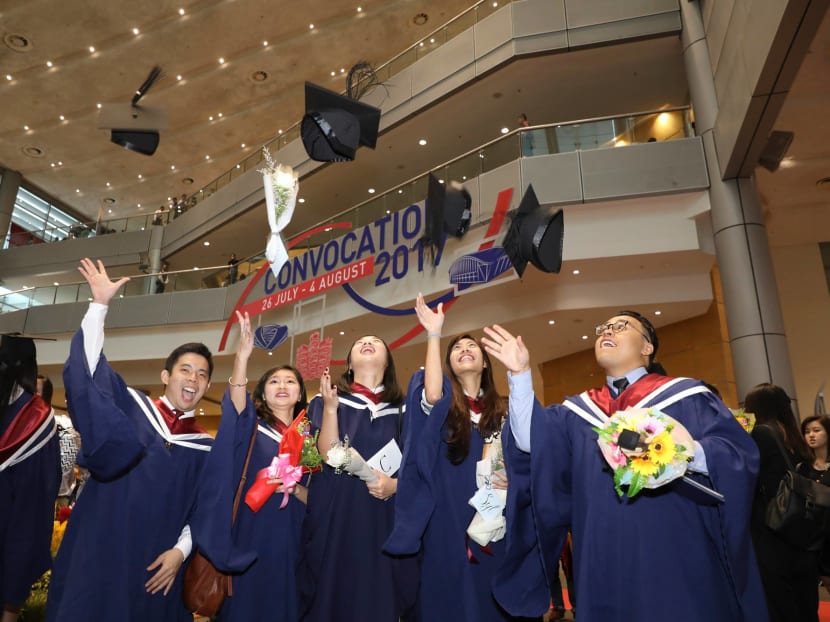Post-grad intake go up for 2 universities, more poly fresh grads not working full-time
SINGAPORE — A check showed that at least two universities here are seeing an increase in the number of Singaporeans pursuing post-graduate studies. This was after the Manpower Ministry (MOM) reported that young people here are more inclined to go for further studies and are starting work later.

The Manpower Ministry (MOM) reported that young people here are more inclined to go for further studies and are starting work later. Photo: NTU
SINGAPORE — A check showed that at least two universities here are seeing an increase in the number of Singaporeans pursuing post-graduate studies. This was after the Manpower Ministry (MOM) reported that young people here are more inclined to go for further studies and are starting work later.
MOM’s advance labour force report, released on Thursday (Nov 30), showed that employment rate fell between June last year and June this year for residents aged 15 to 24. The ministry attributed this to the young having a “higher propensity to pursue further education and postpone entry into the labour force”.
The employment rate for this group was 34.1 per cent in June, down from 35.8 per cent last June and 36.8 per cent in June 2015.
The Singapore Management University (SMU) told TODAY that about 16 per cent more people graduated from post-graduate courses this year, up from 818 last year to 947 this year. It has been an unbroken upward trend since 2011.
Associate Prof Themin Suwardy, the university’s dean of postgraduate professional programmes, said that those taking their master’s degrees from SMU “have grown tremendously in the last few years”, because students find that it can help them “broaden their networks with similarly motivated individuals”.
A spokesperson from the National University of Singapore (NUS) said that over the past year, about 10 per cent more Singapore citizens are pursuing post-graduate studies, bringing the number to 3,400 this year.
Over at the Nanyang Technological University (NTU), there is a “fairly constant” number of Singa-poreans taking up post-graduate studies — around 3,000 this year and last year.
For the polytechnics, data on fresh graduates showed a growth in the number of people on part-time, temporary, or freelance employment — from 31 per cent in 2015 to 34.8 per cent last year. Many of them indicated that they were pursuing or starting further studies. There are no statistics for this year yet.
EMPHASIS ON IMPROVING SKILLS
Associate Professor Randolph Tan, a labour economist from the Singapore University of Social Sci-ences, said that the country needs “a workforce with the breadth and depth of skills”, but it is this need for continual re-training and acquiring of new skills that would “present a new challenge with the millennial workforce”.
Although the younger generation holding higher educational qualifications tends to be open to con-tinual training, these millennials also hold notably different outlooks and aspirations, Assoc Prof Tan noted. This means that policymakers have to ensure that the workforce “has the values required for the future economy”, and that better education translates to a stronger workforce.
He added: “On educational attainment, the Singapore workforce has reached a level that is higher than we have ever seen. That provides the necessary foundation to meet the needs of the future economy. But by itself, more workers with higher educational qualifications — while necessary — is not enough.”
Professor Chew Soon Beng, a labour expert from NTU, said that it is “a good sign” that young peo-ple want to study. “People are rational and they will choose those studies that will make them more employable with higher wages,” he said.
JOB OPPORTUNITIES ‘NOT THAT GREAT’
However, Dr Chua Hak Bin, an economist with Maybank Kim Eng, suggested that the falling em-ployment rates among the younger set may mean that employment opportunities were “not that great” for them, so they “looked to extend their studies”.
“Rather than working in temporary jobs, they go back to school,” he said.
The labour force here is subjected to structural challenges, an official from the labour movement noted. Mr Patrick Tay, assistant secretary-general of the National Trades Union Congress (NTUC), said that these include “challenges as a result of digital disruption, digitalisation, robotisation, mech-anisation and artificial intelligence” in the coming years.
Commenting on the other findings of MOM’s report, Mr Tay said that even though the resident un-employment rate stands at 3.1 per cent, there are “positive signs”.
In a Facebook post on Thursday, he said it is encouraging that employment rate for residents aged 25 to 64 continued to rise to 80.7 per cent, while resident unemployment rate for professionals, managers, executives and technicians (PMETs) is seeing a positive downward trend, along with the long-term unemployment rate.
“(These) suggest that some of our tripartite initiatives in the employment, employability and skills-upgrading of workers — including the progressive wage model — are showing positive effects.” ADDITIONAL REPORTING BY LOUISA TANG
“In an earlier version of this story, Maybank Kim Eng economist Chua Hak Bin was quoted as saying that the drop in employment rate for youth could be a reflection of how more of them are choosing to join the gig economy. The Ministry of Manpower has clarified that those engaged in the gig economy, such as part-time, temporary, and freelance workers, are, in fact, captured as employed persons in its labour force survey.”











